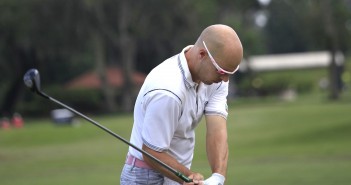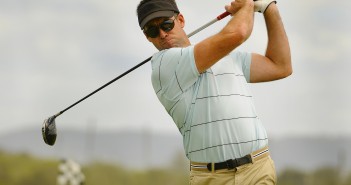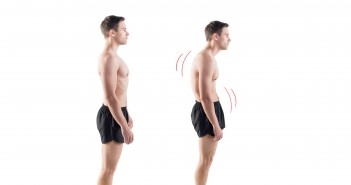We place a lot of emphasis on good posture, having the core muscles activated, and on having the shoulders depressed and “connected” to the core.
With the Golf Loopy Swing like a Champion system, you will learn how to generate more power, accuracy and consistency by powering the golf swing with the big muscles in your legs and core, and that your shoulders transfer that power through to our arms and so to the golf club.
In the golf downswing, by maintaining proper posture and keeping your shoulder blades pulled in, towards your spine and away from your ear, your shoulder complex is positioned for proper functioning of the powerful latissimus dorsi muscle, enabling it to pull you over your left (target side) leg coming into impact. This, in turn, helps you to drive your legs into the ground more efficiently, combining to produce greater club head speed.
If you don’t control your left (target side) shoulder properly, it will lift towards your ear at the beginning of the downswing, which prevents you shifting over to your left side properly, greatly reducing efficiency and power, and putting enormous stress on your lower back as you “hang back” on your right side through impact.
You can get a better understanding of this “power transmission”, and why connecting your shoulders to your core is vital, with this simple experiment:
- Stand with your right arm stretched out in front of your chest, your shoulder blade protracted (abducted, moved forward away the midline of the body; moving the scapula away from the spine) and elevated (moving your scapula up your back);
- relax your arm and shoulder and then turn your pelvis and abdomen sharply to the left;
- you should see how your arm hardly moves, it is “disconnected” – the rotational power of your core is not being transferred to your arm;
- Now stand again with your right arm out in front of your chest, but this time with your shoulder blades depressed (pull them straight down, feel your scapulae slide down your back) and slightly retracted (adducted, moved backward toward the midline of the body; moving the scapulae back toward the spine);
- feeling relaxed but connected, again turn your pelvis and abdomen sharply to the left;
- this time your arm should be pulled around with your torso – the rotational power of your core is being transferred efficiently to your arm.
Another way of thinking about this is to imagine that you want to push a heavy piece of furniture across the floor with your right hand; would you do it with your shoulder protracted or with it depressed and connected?
To learn how you can achieve good posture and get this “connected” feeling, see Golf Swing 101 – Setup: Basic Posture.
If you have any questions or comments about this or other articles on Golf Loopy, please send us an email.
You May Also Like…
Overview of a Great Golf Swing, which summarises the correct movements in a great golf swing.
Golf Swing 101. Setup: Basic Posture
Golf Swing Drill 101. Setup: Perfect Posture and Connecting to Your Core, which describes how to achieve perfect posture.
The Role of the Right Arm in the Golf Downswing, which describes how the right arm transfers energy to the golf club in the downswing.
Golf Anatomy and Kinesiology, a collection of articles describing the roles of the muscles involved in the golf swing.
Core muscles, which describes the muscles that run the length of your trunk and torso.
Latissimus dorsi muscle, which describes the widest and most powerful muscle of the back, and how it is used in the golf swing.
The Role of the Deltoids in the Golf Swing.




